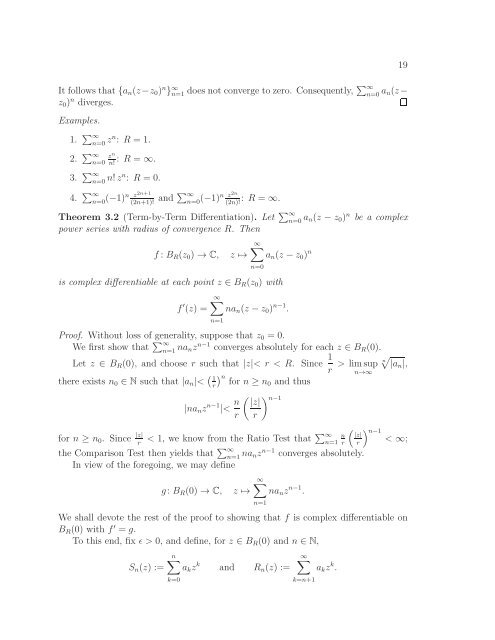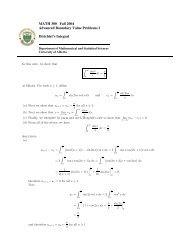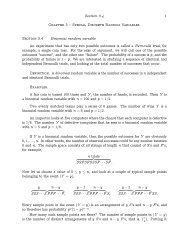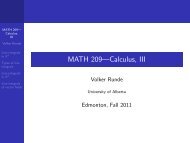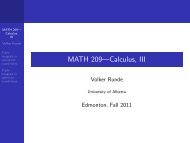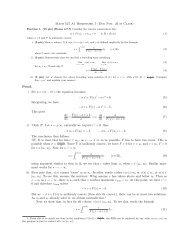Math 411: Honours Complex Variables - University of Alberta
Math 411: Honours Complex Variables - University of Alberta
Math 411: Honours Complex Variables - University of Alberta
Create successful ePaper yourself
Turn your PDF publications into a flip-book with our unique Google optimized e-Paper software.
It follows that {an(z−z0) n } ∞ n=1 does not converge to zero. Consequently, � ∞<br />
n=0 an(z−<br />
z0) n diverges.<br />
Examples.<br />
1. � ∞<br />
n=0 zn : R = 1.<br />
2. � ∞<br />
n=0<br />
zn : R = ∞. n!<br />
3. � ∞<br />
n=0 n!zn : R = 0.<br />
4. �∞ z2n+1<br />
n=0 (−1)n (2n+1)! and �∞ z2n<br />
n=0 (−1)n : R = ∞. (2n)!<br />
Theorem 3.2 (Term-by-Term Differentiation). Let � ∞<br />
n=0 an(z − z0) n be a complex<br />
power series with radius <strong>of</strong> convergence R. Then<br />
f: BR(z0) → C, z ↦→<br />
∞�<br />
an(z −z0) n<br />
n=0<br />
is complex differentiable at each point z ∈ BR(z0) with<br />
f ′ (z) =<br />
∞�<br />
nan(z −z0) n−1 .<br />
n=1<br />
Pro<strong>of</strong>. Without loss <strong>of</strong> generality, suppose that z0 = 0.<br />
We first show that � ∞<br />
> limsup<br />
n→∞<br />
19<br />
n=1nanz n−1 converges absolutely for each z ∈ BR(0).<br />
�<br />
n<br />
|an|,<br />
Let z ∈ BR(0), and choose r such that |z|< r < R. Since 1<br />
r<br />
there exists n0 ∈ N such that |an|< � �<br />
1 n<br />
for n ≥ n0 and thus<br />
r<br />
|nanz n−1 |< n<br />
� �n−1 |z|<br />
r r<br />
for n ≥ n0. Since |z|<br />
r < 1, we know from the Ratio Test that �∞ n<br />
n=1 r<br />
the Comparison Test then yields that � ∞<br />
n=1 nanz n−1 converges absolutely.<br />
In view <strong>of</strong> the foregoing, we may define<br />
g: BR(0) → C, z ↦→<br />
∞�<br />
nanz n−1 .<br />
n=1<br />
� �n−1 |z|<br />
< ∞; r<br />
We shall devote the rest <strong>of</strong> the pro<strong>of</strong> to showing that f is complex differentiable on<br />
BR(0) with f ′ = g.<br />
To this end, fix ǫ > 0, and define, for z ∈ BR(0) and n ∈ N,<br />
Sn(z) :=<br />
n�<br />
akz k<br />
k=0<br />
and Rn(z) :=<br />
∞�<br />
k=n+1<br />
akz k .


